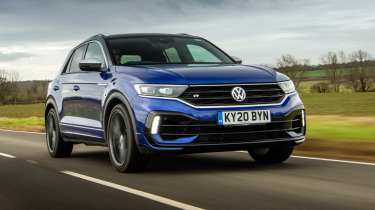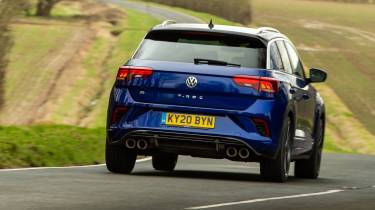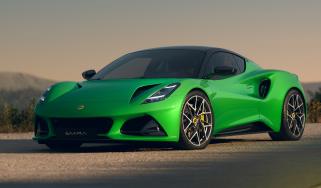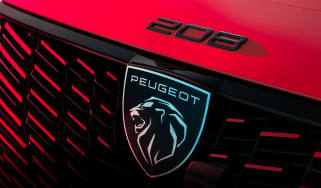Volkswagen T-Roc R Fast Fleet test – six months in the hot crossover
The T-Roc’s time on the Fleet was up after 6000 miles. Did it turn us into crossover fans?
Let’s imagine ourselves in Jost Capito’s garage. I’m not talking about the Williams’ pit garage at a Grand Prix, George Russell plotting his way to another Q3 in a the FW43B. No, I’m talking about Capito’s personal garage, at home, away from his current job as the team principal at Williams Racing.
I should point out that I’ve never been to his garage, nor do I know if it exists. For all I know, Capito may live in a one-up-one-down with limited street parking. But let’s assume he has a nice big house and has kept an example of each of the most significant cars he has been involved with in his career. As we walk through the door and flick the lights on, we see them lined up in chronological order, starting with a BMW E30 M3, because he worked on that car’s engine. Then there is a Paris-Dakar Unimog alongside a Porsche 964 RS. On the shelf behind is one of Kimi Räikkönen’s helmets, as it was Capito who brought him into the Sauber F1 team. Next up are trio of Fords: Mk1 and Mk2 Focus RSs and an F150 Raptor. Then, hiding behind the pickup, there’s another hot hatch – one of the all-conquering Volkswagen Polo WRC cars. And at the end there is a space… for a T-Roc R?
More reviews
> The new Volkswagen Golf R could also be the last petrol version
You see, before Capito left for his current role back in the F1 pitlane, he was in charge of Volkswagen’s R performance division from 2017 to 2020. The T-Roc R is his baby. It was one of the reasons that I was intrigued to run KY20 BYN on the Fast Fleet. Could Capito create a captivating crossover?
But before we get to the dynamic stuff, let’s deal with the rest of the car that has kept me company for the last six months. For a start, it felt like a good size. No bigger than a Golf and therefore a doddle to slot down country lanes and to park in town. Yet, despite being neatly dimensioned, it still felt reasonably practical. Again, hatchback sized, which meant it was ample when it was just me, but capable of fitting a family of four as long as the packing stopped a little way short of the kitchen sink. Huge door bins too. And a secret drawer under the driver’s seat that I only discovered with about a week to go.
The interior certainly stood up well to having everything from car seats to mountain bikes to camera equipment bunged into it. There are a few more hard plastic surfaces than you might expect at the price point (£41,590 before options at the time of writing), so it never felt quite as cosy as the two GTIs I’ve run in the past, but the seats were good on a long journey. An inability to stay in hotels for work meant some pretty lengthy days driving around the country and the T-Roc R was a decent motorway mile-muncher. The mpg would sit in the mid-30s and although I’m not much of a fan of radar cruise control, when the situation was right the T-Roc’s worked well. Having physical buttons on the steering wheel to control it was nice, too.
Just occasionally I was also pleased to be in something with a little more ride height – specifically during the floods that afflicted the countryside round my way during the winter. One night in particular, the T-Roc got me home through two separate stretches of water that I certainly wouldn’t have attempted in a hot hatch.
But did it merit the R badge? Well, it was certainly quick. The claimed sub-5sec 0-62mph time felt entirely believable and the way it ripped through its gears under full acceleration was always impressive and slightly surprising. However, it did feel like it needed to be provoked, because if left in D it would feel pretty lethargic. If you hadn’t pre-empted the need for a swift exit from a roundabout with a few taps on the left-hand paddle then there really wasn’t much enthusiasm to change down on its own.
The turbocharged EA888 could also feel a little gruff and unrefined at higher revs, so it never felt effortless when you began exercising the engine. The extremely expensive optional titanium Akrapovic exhaust did make for entertaining company on a trailing throttle though.
In terms of its handling, the R felt impressively tied down. Despite its flood-fording ride height, roll was kept to an absolute minimum. And yet with the optional adaptive DCC dampers, the daily ride comfort was perfectly acceptable too. It always felt secure and there was no doubting the pace it could carry on a good B-road, but the downside was that it never felt particularly adjustable. You could trim lines a little and make it flow nicely through a set of bends, but it wasn’t an expressive car. Running the dampers in their Normal or even Comfort setting added a little more in the way of interaction with the way the weight shifted, but the essential character remained.
It was, perhaps predictably, but also impressively, very like a Mk7.5 Golf R, but in crossover form. I didn’t love it like I did the GTIs, but I did respect that there was some proper engineering underpinning it rather than just badge-engineering on the grille. You could feel the work that had gone into it. And in one respect it was even better than the Golf R – it was almost invisible as a performance car. The Golf R is hardly attention-grabbing, but a T-Roc R is a veritable Q-car. To that extent, I’m not sure people would notice even if Jost Capito did park one in his garage.
| Date acquired | December 2020 |
| Duration of test | 6 months |
| Total test mileage | 6073 |
| Overall mpg | 30.5 |
| Costs | £0 |
| Purchase price | £45,970 |
| Value today | £36,000 |
This story was first featured in evo issue 289.






